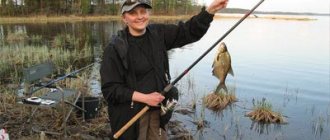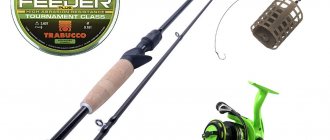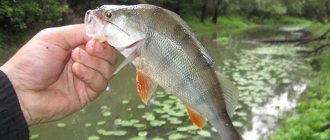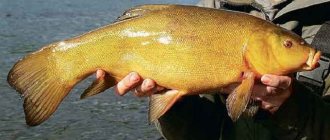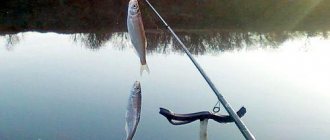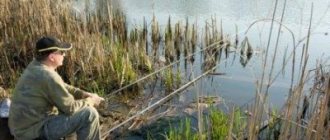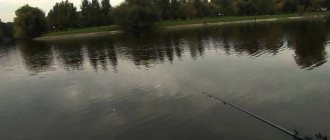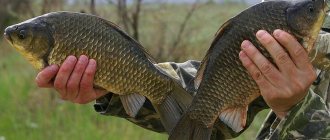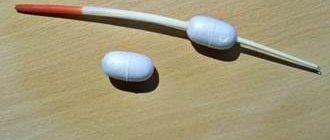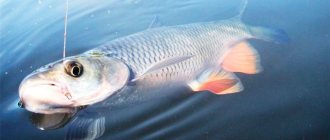The most optimal tackle for catching bream is a fly rod. Its equipment will not cause problems for a novice fisherman and does not take much time.
Avoid sandy bottoms; bream prefer muddy bottoms or places with a lot of shells. When fishing from the shore, you should focus on clay cliffs, the mouths of streams and ravines.
The choice of place when fishing for bream depends on:
- wind direction;
- the depth at which you are going to fish;
- bottom structures.
Try to choose a fishing spot where the wind blows in your face. Bream really like surf spots, although it will be difficult to cast with a light float. This is all compensated by a good catch.
Rules of conduct for fishermen
The season for catching bream with a float rod begins when the water warms up to 17-20 °C. In our area this happens in late May early June. The water level in May is still quite high, and without a wading suit you simply cannot reach many places. The intense bream bite on river rapids ends in the first half of September. I won’t give any special recommendations on the time of day. I had to catch bream both in the morning and in the very heat. The main thing is to guess the weather correctly.
Their selection is quite wide.
Lure
Usually, to attract bream, traditional mixtures for carp fish are used - both factory-made and home-made. Cake, ground or breadcrumbs, sunflower seeds, rapeseed, etc.
Good additives for bait are:
- powdered milk,
- oatmeal,
- lightly toasted grains
- steamed bran,
- compound feed,
- porridge.
The main thing is not to overfeed the fish. The bait must contain components of the attachment or bait that you are fishing with. It is very important not to overfeed the bream. The bait should be added in the smallest portions. As you know, “underfeeding” is in any case better than “overfeeding.”
The thinnest fishing line should be used for catching bream from the shore. Bream is a very cautious fish, and a thick fishing line can simply scare it away.
How does bream bite?
It is known that bream leads a purely bottom-dwelling lifestyle. In the course of evolution, it has ideally adapted to feeding in the mud without expending a lot of energy. Among the specific adaptations are the unique tubular mouth of the fish, and its original physique - a high rhombic body, specific tail and other fins. All this is necessary for the bream in order to deftly rummage through the bottom sediments - in search of invertebrates that live there.
Considering that, in parallel with digging in the mud, the fish needs to monitor the environment for danger from natural enemies, the bream has developed the following feeding algorithm: having detected a food object by smell or vibrations, it hovers above the bottom, quickly tilts towards its surface at an angle of approximately 40° (at the same time, its muzzle can go somewhat deeper into the silt), even faster it sucks in a small portion of silt along with invertebrates, immediately takes a horizontal position and “chews” what it has sucked in, separating food objects from the inedible soil, which it immediately spits back out.
At the same time, bream is very picky about food and picky about its “quality”. If he doesn’t like something (the smell is not right, the mass is too large, etc.) he will spit it all out and swim back to his own place to sniff and listen to the silt for bloodworms.
It is quite obvious that this behavior greatly affected the bream bite when catching it with float tackle. Not to say that he is very careful, like, for example, crucian carp, but any mistake in setting up the tackle or feeding the bait will result in a blank hook for the fisherman - the bream will simply have time to spit out the hook with the nozzle before the catcher’s hand twitches.
Therefore, to avoid empty hooks, you need to fine-tune the tackle and provide good bite signaling.
Fishing line for bream
The thinnest fishing line should be used for catching bream from the shore. Bream is a very cautious fish, and a thick fishing line can simply scare it away.
Thin fishing line also significantly reduces the windage of the tackle, and makes it possible to use light weight sinkers and small sensitive floats, even in windy weather. By reducing the diameter of the fishing line by 0.08 mm, you will immediately gain much greater controllability and stability of the gear in gusts of wind.
When fishing, it is always advisable to monitor the position of the fishing line from the tip of the rod to the float. This part of the fishing line needs to be sunk after each cast so as not to load it with waves and surface movement of water. This is not difficult to do by twitching the line with the tip of the rod near the water from side to side.
After preparing the tackle, all that remains is to fill the cormak with bait, lower it to the bottom and start fishing. It is best to choose a depth so that the hook moves almost along the bottom. By the way, install the float so that you can only see its tip. When fishing in a retrieve, the bream does not put the float on the water, it only drowns it. Wiring must be done on a selected section of the river, 10-15 meters, as described above.
Float color for bream
When choosing the color of the float for bream, you should be more guided by the fact that you can better see the float and bites. In order for the float to be clearly visible, it is desirable that it have contrasting multi-colored stripes on the rod or, in extreme cases, just a contrasting tip, so that you can easily determine whether the float is flooded or raised when biting.
The bream doesn't care what color float you use. After all, most often bream fishing occurs at a decent depth, so the fish will not even notice your bite alarm. But still, you should not use floats with very bright colors on the bottom, so as not to alarm the fish once again.
It is important to know!!! In dark water, a float with a contrasting white or light green top is better visible, and in light or bright water - with a red or black one. And the lower part of the float should resemble the objects in the water in color - algae or branches.
Catching bream with a float rod from a boat in the current
Catching bream with a float rod from a boat is divided into two types. The first includes fishing in bodies of water with a current, and the second in still water.
A special feature of catching bream in the current with a float rod is that you can use two types of rods. And the first type of fishing rod is the Bolognese rod; fishermen call this type of fishing jigging. You can catch bream with a Bolognese fishing rod immediately after the ban is lifted, that is, after spawning. In this case, the boat is secured to two anchors in a rigid position. If this is not done, it will be swayed by the wind and current, which will interfere with proper wiring.
[THERE IS AN ANSWER] How to make a feeder tackle for bream
The choice of place for fishing depends on the fishing method. Choose a section of the river 10 to 15 m long with a flat bottom topography and without aquatic vegetation on the bottom. It is desirable that the depth on it be about three meters.
This method of catching bream will be effective both in autumn and summer, and even more specifically, in both August and September. Rigging a float rod for catching bream with a Bolognese rod is not very complicated. All you need is a rod, 4 to 6 meters long, always with rings. The lighter the stick, the easier it will be for you. It is best to choose a match reel. But if you don’t have one, then any other size from 800 to 1000 will do.
It is better to use a thicker fishing line, but without fanaticism, 0.2 mm will be quite enough. Hooks from number 12 to 16. A leash up to a meter long must be connected to the main fishing line using a carabiner. The weight of the float is selected depending on the current speed and depth.
And of course, don’t forget about Cormac. Often this is a square made of metal mesh. If you are too lazy to do it, then a fish tank will do just fine. The main thing is to put a weight on the bottom. The weight should hold the cormak in place, preventing the current from washing it away.
The bait is the fisherman’s choice; I recommend using maggots. Pea mastyrka also works well.
After preparing the tackle, all that remains is to fill the cormak with bait, lower it to the bottom and start fishing. It is best to choose a depth so that the hook moves almost along the bottom. By the way, install the float so that you can only see its tip. When fishing in a retrieve, the bream does not put the float on the water, it only drowns it. Wiring must be done on a selected section of the river, 10-15 meters, as described above.
You need to lower the hook directly near the feeder, and then release the line with the current, periodically holding it. After the float reaches the extreme point, you should not immediately pull it out. Wait until it is lifted by the current, very often at this moment the bite occurs.
Catching bream from a boat with an onboard fishing rod
Catching bream in the current requires considerable effort from the angler. Those who don’t like this don’t be confused, there is a way out for them - catching bream from a boat with an onboard fishing rod. Groundbait, bait, tactics and fishing techniques remain the same. Only the equipment changes.
Here we use short rods, a little more than two meters long. The end of the rod is equipped with a rigid nod. A fishing line is passed through the nod. The reel is the same as in the method described above, the fishing line, leash and hooks are the same. The main thing is not to make the leash shorter than a meter.
The sinker should lie on the bottom and keep the hook close to the feed. The load is secured using both sliding and blind mounting. Flat weights hold the equipment very well. But you can use other forms, as long as it keeps the tackle in place. The bream bites very sharply.
The best way to catch bream on the river is with a Bolognese fishing rod. It allows you to accurately and realistically present the bait using the force of the current.
Rod length
As already noted, catching bream with a float rod is always a significant distance, therefore, the rod must be of the appropriate length. The use of telescopes shorter than 8 m is almost pointless. The longer the rod, the greater the chances of success, that is, the length of the rod is directly proportional to the possible fishing efficiency. Therefore, it makes sense to consider rods in the length range from 8 m to 11 m. However, it should be remembered that as the length of the rod increases, the pressure on the fisherman’s hands also increases due to increased leverage. And, in this regard, the weight of the rod plays an important role. And this is directly related to the class of the rod. The conclusion suggests itself: the longer the rod, the higher its class should be. Otherwise, the process of fishing from pleasure can turn into exhausting work. For example, a modern high-end 9-piece weighs 450-500 g, top models of the same length weigh no more than 400 g, and they exert almost half as much pressure on the fisherman’s hands. And since the class of a fishing rod directly determines its market value, the task comes down to finding the optimal balance between comfort and wallet. Expensive fishing rods from leading brands are made from modern, high-tech materials that reduce the weight of the product through the use of carbon fibers that have higher physical and mechanical properties.
Varieties of fishing rods and rigs
To outwit the wary bream, anglers have come up with several options for float rods. Each piece of gear can be effective when used correctly.
Fly fishing rod
Some modern fishermen classify the fly rod as outdated gear. But in skillful hands, the swing can give odds to expensive gear. Float fishing for bream using fly tackle is suitable for fishing in oxbow lakes, dumps close to the shore, as well as when using watercraft.
Photo 2. Modern fly fishing rods.
- The main element of the fly rod is a lightweight carbon fiber rod without guides or a reel seat. The length depends on the fishing method. For coastal fishing, 5-7-meter models are suitable, and when fishing from a boat, the length can be limited to 4 m.
- The equipment of a fly float rod for bream consists of a 0.18...0.22 mm fishing line, a sinker, a float and a leash (0.16...0.18 mm) with a hook. The good thing about the swing is that you can make several rigging options at home. For quick replacement of equipment, the rod has a special connector.
[THERE IS AN ANSWER] How to put a bloodworm on a bream hook
Match tackle
When bream feeds away from the coastline, a match rod helps to reach the fish. Its main trump card is long-distance casting of the bait.
Bolognese fishing rod
The best way to catch bream on the river is with a Bolognese fishing rod. It allows you to accurately and realistically present the bait using the force of the current.
Plug tackle
The most modern float fishing rod, which allows you to catch bream at a distance of 10-14 m from the shore, is considered to be a plug. Thanks to a special cup, the plug rod allows you to accurately deliver bait to the fishing point.
Now that a sufficient amount of factual material has accumulated, we can begin to generalize our experience and give some recommendations for catching bream with a float rod on river riffles.
Bologna rod and its equipment
One of the most common fishing rods is the Bolognese. It is a telescopic rod with rings attached to it. Any type of reel is suitable for this rod, from the simplest to the spinning reel. One of the advantages is that the lap dog is suitable for any type of reservoir.
The heavy rig makes it suitable for precise long casts, and the simplicity of the design makes disassembling it an easy task. However, there are also disadvantages. These include weight, which is significantly greater than in the flywheel. But the disadvantage is easily eliminated by using high-quality, renowned brands that have been producing ultra-light plug rods for a long time.
Also, guide rings increase the wear of the fishing line, which is why, with frequent trips, you will have to change it more often. There is no need to buy a new spool of fishing line, just unwind the “worn out” section from the reel and the fishing line will be as good as new.
What shape is best to use a float
The choice of float is not critical. Almost any option will do. Preference should be given to one or the other depending on different fishing conditions:
- If stability is important, and active bite makes it possible to ignore sensitivity, then you should choose a barrel-shaped float. Provided the wind blows while fishing, a barrel is a great option. When biting, it will lie on its side, which cannot be ignored, and during gusts of wind it will maintain a stable position.
- In calm weather and still water, a feather-shaped float is the best choice. High sensitivity, but poor wave stability.
- Shallow water works best with a float in the form of a shortened feather. Low resistance reduces the likelihood of the bream leaving when biting.
- A universal solution would be a cone-shaped float. Regardless of the type of reservoir and the presence of wind, it performs well, maintaining a balance between sensitivity and stability.
Float colors
The choice of float color is made solely according to the preferences of the fisherman himself. Bream does not pay attention to the float, because fishing takes place at depth. So when choosing, you should choose the color that will be noticeable to you. You can choose a contrasting and multi-colored option.
It is recommended to choose a float with a white top for dark water, and a black top for light water. To be on the safe side, the bottom of the float can be painted dark green to resemble seaweed.
How to load tackle correctly
There are several basic loads, varying depending on the chosen fishing rod:
- Bolognese fishing rod. The main load is attached 20 centimeters above the intermediate load. Makes up 60% of the total weight of the load. Intermediate load - a small amount of pellets is used, attached above the under-groove at 20 centimeters. The under-hook is attached to the loop on which the leash is attached. Weight - 0.2 grams
- Match fishing rod. The main load is an “olive”, which is attached based on calculations: the length of the float multiplied by one and a half. Important! Match floats have their own weight, take them into account when choosing the weight. Podpodok - a pellet is used, which is attached to the loop of the leash and fishing line. Weight - 0.2 grams
- Fly rod. The main load is attached 20 centimeters above the intermediate load. Makes up 60% of the total weight of the cargo. Intermediate load - one pellet is used, attached 15 centimeters from the under-grazing. Podpodak - a small number of pellets, attached to the loop of the leash and fishing line. Weight - 0.2 grams
- Plug fishing rod. The same method is used as for the fly rod. The only difference is that parts of the load are spaced apart to increase sensitivity if long casts are needed.
Fishing time
The season for catching bream with a float rod begins when the water warms up to 17-20 °C. In our area this happens in late May early June. The water level in May is still quite high, and without a wading suit you simply cannot reach many places. The intense bream bite on river rapids ends in the first half of September. I won’t give any special recommendations on the time of day. I had to catch bream both in the morning and in the very heat. The main thing is to guess the weather correctly.
Don’t be surprised, our grandfathers made bait more attractive to bream by adding natural honey to it.
Bream tackle for fishing from the shore
When fishing with a float rod with a “blind” rig, the winner is often the angler who, through trial and error, is able to choose a tackle for himself where the errors of individual elements are minimized.
The main element is the fishing rod. The casting range and accuracy, the softness of the hook, and the degree of shock absorption during jerking and landing fish depend on its characteristics.
For catching bream from the shore, the most suitable rod is of medium hardness, which allows you to deliver the bait to the feeding area without any problems, not only in calm conditions, but also in side and head winds.
However, it should be borne in mind that the stiffer the fishing rod, the thicker the main line and leash have to be installed. And this, as a rule, slightly reduces the number of bites.
The disadvantages of soft rods include the inability to cast accurately and the unpredictable behavior of the rod tip when hooking.
So, how to choose equipment so that when casting and presenting the bait it does not arouse suspicion in such a cautious fish as bream.
It is well known that fish often have to be caught using baits lying on the bottom. And this, in turn, determines the choice of float design and optimal loading options. Because an inappropriate garland of sinkers can alert the bream. The chances will increase if you use two sinkers - one, the main one, located 20 centimeters from the bait, and the other, which lies directly on the bottom and is 10 centimeters from the bait.
But the main thing is to properly surround the float, preferably at home. The bream float is loaded so that the main sinker completely drowns its body. The weight of the under-shepherd is selected so that in the working position the long antenna extends only 1-2 millimeters out of the water.
Bream is a tall-bodied fish. To take the bait from the bottom, it takes an inclined position. Raising the bait slightly, the bream savors it for a while. Then it becomes horizontal and begins to move to the side and to depth. At this time, the float rises, most of the antenna comes out of the water, signaling us about the progress of the bite. This loading method is also called the “lift method”.
These are the basic requirements for catching bream from the shore with a float rod with a “blind” rig.
Float tackle for long casting
Usually it helps out the fisherman when the bream feeds away from the shore or for some reason ignores the coastal zone (for example, when fishing on a flat bottom, where the depth does not exceed 2-3 meters).
In this case, the rod with rings is equipped with a spinning reel, which allows you to cast tackle up to 30 meters or more. The sliding float can have one or two attachment points. Most floats for long-distance casting are made with internal weighting. When fishing for deep-sea fish, including bream, their carrying capacity is from 5 to 15 grams. The upward movement of the float is limited by a stopper knot, which is knitted from a thicker fishing line than the main one, or by a magazine stopper.
Tips for fisherman: Reel for winter fishing rod for trolling - All the nuances
The advantage of long-casting gear is that at a distance from the shore, the bream takes the bait more decisively and boldly. The downside is that it is difficult to feed the point. And also with an increase in the weight of the load, the sensitivity of the gear is lost.
The rod is usually selected as long as possible, taking into account the specific fishing conditions and physical strength of the fisherman.
Lure
In the composition of the bait, the lion's share belongs to breadcrumbs and ground sunflower seeds. This mixture is supplemented with rolled oats, millet, peas, and buckwheat, which are pre-roasted.
If you plan to hunt for large individuals, you cannot do without light ingredients - bran, cake. It is advisable to saturate these ingredients with water and boil them in boiling water. If you refuse to cook, the light components of the ball will float up, which will collect the small fry and other small fish that live on the surface of the water.
Why grind the ingredients of bream bait? Bait with small components begins to work faster. At the same time, the fish becomes saturated more slowly and therefore the bite lasts longer.
Tip: supplement the bait with dry milk. True, if you overdo it, the ball will become viscous, but we need a crumbly one.
Don’t be surprised, our grandfathers made bait more attractive to bream by adding natural honey to it.
When choosing a store-bought flavoring, preference should be given to compositions with the scents of fruits, berries - raspberries, pears, bananas... The aroma of vanilla and cinnamon will not hurt.
The ideal bait also includes small animal components. We are talking about crushed worms, bloodworms, and maggots. River sand, clay and earth act as ballast for the ball.
For me, the advantage of catching bream is that you usually don’t have to drill holes in the cold. If you wish and have a hook, you can pull out a kilogram fish into the hole from the 130th drill. Handle more with seasoned bream - additional work with a drill or an ice pick follows.
Bait and baits for catching bream on float tackle
When catching white bream, various baits are used. The basic ingredients are boiled millet, pearl barley, rolled oats, peas and breadcrumbs. Together with these components, store-bought roach and bream mixtures are used.
If we fish in early spring or late autumn, in cold water, we use dark baits, black and brown. They should not have strong sweet odors. We add soil to the composition, which will slightly deplete the bait. If we fish in the current, we make the bait more viscous. We roll it into balls and add more clay, rolled oats, pearl barley, which glue it into one whole.
There is one rule: the stronger the current, the more flavored the bait should be. Spicy and fishy scents work well in cold water. In summer, the ideal aroma for bream and white bream is chocolate. Vanilla and fruity scents are also suitable: melon, pineapple, tutti-fruiti.
When fishing in quiet places, we make the bait lighter and more airy, so that the balls, having reached the bottom, immediately begin to fall apart, creating a bait spot. Grains will lie at the bottom: millet, pearl barley, and small particles will rise and create a cloud of turbidity.
Here is one of the working bait recipes:
- Breadcrumbs, white – 500 grams;
- Bran – 500 grams;
- Ground roasted seeds – 250 grams;
- Ground hemp seeds – 100 grams;
- Vanillin packet;
- White bread - 300 grams;
- Semolina – 100 grams;
- Boiled millet – 300 grams.
It is better to roast the seeds in the microwave. There they will fry evenly and not burn. Just take a large plate and pour the seeds into it. Place in the oven for 3 minutes, then stir them and place for another three minutes. As a result, in 6 minutes we will get the finished product. It is better to grind them in a regular meat grinder with the addition of bread and sunflower oil. Pastoncino is also added to the bait mixture. These are colored pieces that highlight the bait at the bottom.
Another component is vanilla cookies. In the markets you can buy cheap broken cookies, which are ideal as bait. It is used in the summer, especially when fishing from a boat.
Animal and plant baits are used equally for catching bream. These are cold water bloodworms, worms, white and colored maggots. Vegetable baits that work well include pearl barley, dough, puffed dough, corn, mastyrka, and peas. By combining plant and animal baits, you can achieve an excellent bite.
Proper rod rigging
The float rod tackle is the most obvious. You need a rod, float, line, reel and sinker with a hook. Due to the inexpressive physical strength of bream, a medium action rod is suitable for fishing. In addition to the fact that the bream quickly runs out of steam and turns to its side, which allows you to easily pull it onto land, with such a rod you can make more accurate casts compared to a rigid one. Recommended length is 9 meters.
The fishing line must be chosen with the expectation that the bream is careful. A thin, strong fishing line with a cross-section of 0.25 millimeters is suitable. The leash should be thinner, within 0.16 millimeters. Speaking of quality, it’s better to overpay and choose fishing line from a reliable manufacturer than to miss the fish. An inertia-free reel with a soft friction is perfect for catching bream.
It is best to attach the load along the fishing line according to the principle “heavy on top - light on the leash.” This is necessary so that the bream does not feel the weight when lifting the bait and does not refuse the treat. The lowest and lightest weight is called the “underweight”; it is necessary in order to hold the bait in a vertical position, and at the same time not create much resistance during the bite. With this installation, the fish takes it more confidently, since it does not feel the weight of the loads.
What floats to use
Choosing a float is an important part of successful fishing. We recommend oval-shaped floats with double-edged ends and a height-to-thickness ratio of 3:1. Ideally, you need a long carbon fiber keel and an antenna 1.2 millimeters in diameter.
The carrying capacity varies depending on the depth at which you are fishing, as well as the waves and behavior of the bream itself. If the fish is active or you are at great depths, then a larger load is needed; in strong waves, it is worth adding a longer antenna to the load. All equipment should be prepared in advance in duplicate in case of breakage.
How to choose a float:
- If there is no current at a depth of about five meters, you can use a float with a carrying capacity of 2 grams.
- In case of inactive bite, it makes sense to choose a 1 gram float.
- When the fish is active and constantly interacts with the bait, it is worth increasing it to 4 grams.
- If active bleak does not allow the bait to sink to the bottom, you should choose a 6 gram float
Wobblers that catch 100%:
Shimano FX
More details
Shimano FX
More details
Shimano FX
More details
Shimano FX
More details
Hooks used
The choice of hook is primarily determined by the choice of bait. If a worm is used, you will need a hook with a long shank, otherwise it will not be secured well. If you fish with vegetable baits, then a hook with a short shank is suitable.
Baits such as bunch of worms require a size 6-8 hook with a fairly long shank. Otherwise, the bait will simply slide off. Bloodworms, caddis flies and maggots will require No. 12-14. For steamed corn and other vegetable baits, No. 8-14 with a shortened shank are suitable.
The tip should be bent inside the bend with the sharp part. It will be more difficult for the fish to escape from such a hook when biting. The color should be chosen based on the color of the selected bait, but shades of blue are more often used. Remember that the bait must be partially reflected in the groundbait.
About the habitats of bream
Unlike bottom fishing, for which the hottest month is August, fishing with a fishing rod and float is preferable in colder weather, especially on the river. This is explained by the fact that in the heat, bream goes to the maximum depth, escaping from the uncomfortable temperature.
In the cold, he tries to stay close to the shore. Try to fish closer to dusk. Among the features of the area, it is worth giving preference to clay soil with the presence of silt. The sandy bottom rarely boasts bream habitat. Holes and dips that sharply increase the depth near the shore are ideal places for fishing.
Terrain with a gradual deepening is also suitable for long casts. In summer, bream is predominantly herbivorous and stays in places with weak currents and a large amount of plant food.
You can understand where bream live by noticing many bubbles rising to the surface of the water. This means that the school is looking for food among the mud. On average they live 8-10 meters from land or near the center of a river channel.
Basic food and bait
Ready-made baits can be purchased in specialized stores, but since most people like to prepare them themselves, here is the basic recipe for the mixture: bulk (1 kg), slightly undercooked peas (1 kg), steamed millet (1 kg), dry Hercules flakes (1 cup). They also add additional earth to the mixture (if fishing in shallow waters and slow currents) or clay (if there is a strong current) from 1 to 3 kilograms. The first feeding should make up the majority of the total. After about 40 minutes, you can throw in a little more complementary food, gradually adding it after each fish caught. If possible, try to feed the fishing spot in the evening.
Pleasantly smelling bait will attract bream even more; for this purpose you can use vanilla, coriander or anise, but do not overdo it!
There is a large selection of different baits for catching bream.
All of them are divided depending on their origin into:
- vegetable (used only in summer). You can use barley, semolina with flavoring, mastyrka (corn with peas), steamed peas and canned corn;
- animal origin (used at any time of the year). They often use bloodworms (quickly removed with small change in the summer), maggots, and worms;
When fishing with bait of plant origin, use a leash less than 15 cm, otherwise it should be at least 30 cm.
Try to hold the bait on the bottom for a few seconds, so the bream will react faster.
So, how to catch and with what? Bloodworms, maggots, pearl barley and dough are what suit him best. They can be alternated depending on the bite.
orybalke.com
Bait for bream
The second stage is preparing bait; it is better not to go fishing for bream without it.
There is no single recipe for universal bream bait; its composition depends on the conditions at the fishing site and the personal preferences of the fisherman.
In any case, the basis is vegetable - cakes, crackers, sunflowers, peas, other seeds and cereals, bran and animal feed. When fishing in stagnant water, they try to prepare the bait so that it does not have large fractions - grind it in a meat grinder, if necessary, pre-steam and fry it.
Flavorings are also added (in moderation) and milk powder, which creates clouds of turbidity at the bottom, which are very attractive to bream.
The remaining components depend more on the personal tastes of the angler, rather than the fish. Some add sugar and even honey in the belief that bream is partial to sweets. Or cocoa powder. There are staunch supporters of castor oil, which supposedly speeds up the digestion of bream. Many “secret” components actually work well, but only for a specific body of water - and there can only be one piece of advice here: you need to try and experiment, it is possible that your personal “secret” weapon will become something completely unexpected...
Another question does not have a clear answer: to add or not to add animal feed? Most anglers do not add fish when fishing in still water, partly for economic reasons. And for those who add, the results are mixed...
Feeders are usually not used when float fishing (there are exceptions, but they are rare), the bait is mixed with loam or sandy loam on the shore of the reservoir and served to the fish in the form of balls thrown into the water. It is clear that this method of feeding makes fishing at too long distances pointless - the thrown balls are scattered over a large area, and with them the fed school of bream.
The baits for summer bream fishing are quite varied. The most commonly used animals are crawling and ordinary worms, bloodworms, maggots, as well as a “sandwich” of various combinations of them. Vegetable grains include barley grains, wheat, corn, peas (boiled or steamed) and dough prepared according to a variety of recipes. But the list of these most commonly used attachments is far from exhausted. It happens that in one place or another, bream prefers something more exotic to other baits, for example, pearl barley meat or large white larvae.
Bream search methods
The success of fishing largely depends on a well-chosen fishing spot. During daylight hours, bream prefers to move actively, which explains the fact that the bite suddenly begins and fades.
In calm weather, a feeding flock can be identified by bubbles on the surface of the water. However, keeping the bream at one point can be difficult. Heavy feeding can scare away fattening fish if the area is in shallow water. Therefore, there are more reliable ways to detect prey.
The first and most reliable method is to search for bream with an echo sounder. Indeed, the miracle of modernity lies in high-tech devices that make life easier. The average fisherman does not always use a fish finder. There is a budget way to find bream.
A marker rod is an indispensable thing on a new body of water . Using a sinker and a large sliding float tied to the end of the cord, the angler determines the depth, bottom structure and relief. Of course, this method will not show fish, but it will help you find a promising place.
A marker fishing rod is a rigid spinning rod capable of long casting. After the sinker falls to the bottom, the angler begins to release the line, pulling it with his hand on the released clutch. The amount of monofilament wound is measured mentally, so the approximate depth can be calculated. After this, by winding the reel, the float is lowered to the load, and the fisherman drags the latter along the bottom.
If the sinker moves easily, this means that the bottom is muddy or sandy. Silt is characterized by the fact that the lead collapses under its own weight, and resistance appears at the beginning of the next pull-up. Sharp jumps indicate a shell or pebble. Interesting areas are fixed with a clip, after which the angler can choose the most suitable area for fishing.
Time and place of fishing
Bream is a prominent representative of schooling fish species. Once you find a feeding school, you can catch a lot of fish, both in number and weight. Unfortunately, some anglers completely drive out the school, taking the entire catch home. Because of this approach, the bream population in some rivers and lakes has decreased significantly.
A characteristic feature of this representative of the ichthyofauna is its bottom lifestyle. The fish's tube-shaped mouth is capable of sucking up food that is located at changes in depth. It is on steep slopes that the most productive fishing occurs. Bream lives in large lakes, reservoirs, and rivers where there are depths of over 5 m. But schools feed throughout the entire water area, it all depends on the time of year.
- In spring, bream leaves their wintering pits, rushing to warmer water areas. Here the fish actively feeds, restoring its caloric reserves before the mating season. In early spring, it is possible to catch fish close to deep holes. Fishing for bream with a fishing rod can occur along the coastline, where worms and insect larvae get caught with melt water. The approach of the spawn is indicated by numerous small tubercles on the males’ heads. Spawning begins only after the water warms up to 21ºС. In the southern regions of the country, spawning occurs in mid-April; in the middle and northern regions, fish are ready to spawn only in May.
- At the beginning of summer, spawned bream begin to wander throughout the water area in search of food. For some time it is possible to catch large fish near spawning grounds at shallow depths. The warmer the weather gets, the more difficult it is to count on a good bite from the shore. Even with a boat, it is possible to collect several individuals only with abundant bait. In this regard, local fishermen have an advantage. Daily baiting allows you to accustom the bream to certain points of the lake or river. The fish will approach the generous shore in the morning or evening, and the rest of the time will hide in the deep parts of the reservoir.
- Bream fishing is considered the most promising in September. Instinctively, fish begin to gather in schools before wintering. First, small groups stand on the baited spot, then the number of fattening individuals increases. This behavior must be taken into account when determining the amount of bait for fishing. Before freeze-up, bream becomes capricious and cautious. In clear water, you can deceive the fish by using the thinnest equipment.
Photo 1. Snag is one of the most catchy places.
